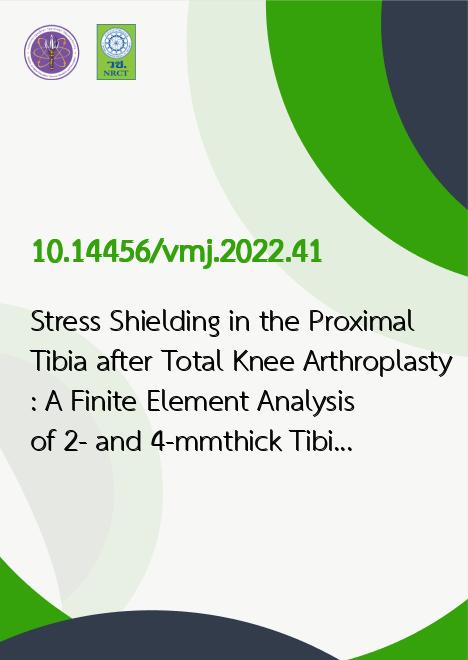
|
Stress Shielding in the Proximal Tibia after Total Knee Arthroplasty: A Finite Element Analysis of 2- and 4-mmthick Tibia Prosthesis Models |
|---|---|
| รหัสดีโอไอ | |
| Creator | 1. Pruk Chaiyakit 2. Krittamuk Ompornnuwat 3. Natthapong Hongku 4. Pattanaphong Janphuang |
| Title | Stress Shielding in the Proximal Tibia after Total Knee Arthroplasty: A Finite Element Analysis of 2- and 4-mmthick Tibia Prosthesis Models |
| Publisher | Text and Journal Publication |
| Publication Year | 2565 |
| Journal Title | Vajira Medical Journal |
| Journal Vol. | 66 |
| Journal No. | 6 |
| Page no. | 397-406 |
| Keyword | finite element analysis, total knee arthroplasty, deformation of tibial tray, stress shielding |
| URL Website | https://tci-thaijo.org/index.php/VMED |
| Website title | Vajira Medical Journal (วชิรเวชสาร) |
| ISSN | 0125-1252 |
| Abstract | Objective: Proximal tibial bone resorption and osteolysis after total knee arthroplasty occur despite improved design and manufacturing processes. We utilized finite element analysis to study these phenomena. Methods: We use SOLIDWORKS 2018 software to study stress and displacement of normal tibias and tibias implanted with a 4-mm-thick CoCr tibial tray (4mm-tray) or 2-mm-thick titanium alloy (2mm-tray). Under vertical loads of 1000 or 2000 N, the stress and displacement of both tibia tray models were analyzed. Stress on the supported proximal tibia 1 and 2 cm beneath the surface was analyzed and compared to stress in a normal tibia. Results: Stress concentrated around the central region compared to the peripheral region in all models, which caused more deformation of the material in the central region. However, the 4mm-tray exhibited a more rigid construct compared to the 2mm-tray. Under any load, the 2mm-tray exhibited more tray deformation, with a centralperipheral deformation difference of approximately five times more than the deformation difference for the 4mm-tray. Moreover, stress on the peripheral region of the supported proximal tibia was only 1822% of that of a normal bone for the 4mm-tray compared to 5466% for the 2mm-tray. Conclusion: Both tibial tray implant models exhibited some degree of stress shielding on the peripheral region of the supported proximal tibia. However, the greater modulus and thicker baseplate construct of the 4-mm CoCr tray exhibited a profound stress shielding effect. This stress shielding may correlate with a higher incidence of proximal tibia bone loss. |